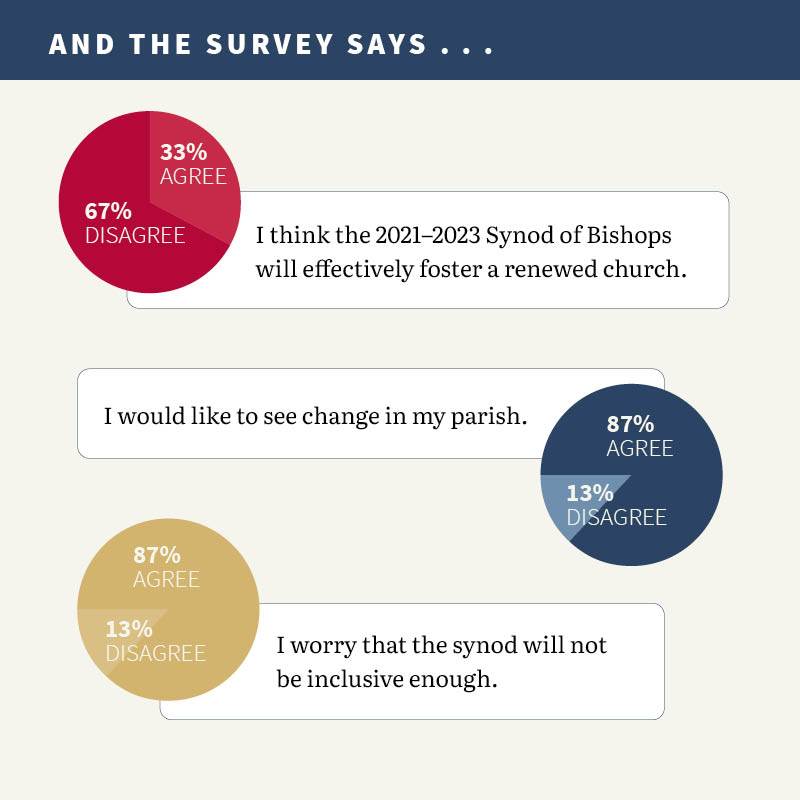As the synodal consultation process gets underway, I’ve heard from several diocesan lay leaders throughout the country about how concerned they are that this process will not be inclusive. Many fear that only a single group of people, primarily from leadership councils in parishes and dioceses, will be asked for input during this initial stage. Others share how parishes continue to serve only the dominant group in the community and are not inclusive of all cultural communities. What is painfully obvious is the lack of diversity in areas of leadership and the lack of centering the experiences of those parishioners at the margins.
This lack of representation speaks to an unwillingness on behalf of the U.S. Catholic Church to come to terms with a multicultural understanding of Catholicism in parish life, an understanding that celebrates diversity and inclusion of all cultural families present in the United States. Isn’t that a goal of the global synodal process: to include all diverse voices and perspectives in this journeying together?

As we begin this synod, I hope that those leading the parish consultation process will welcome, promote, and integrate all cultural families found in our parishes. In particular, I hope that the importance of multilingual ministries and inculturated religious practices will be recognized and thoughtfully addressed during the process.
Language is one key element of a people’s culture, and to celebrate the Mass in the vernacular is to implement the teachings and spirit of the Second Vatican Council. As such, any dialogue about the church’s future must take into account that the church in the United States is home to speakers of many different languages. However, many parishes do not provide multilingual services, either on Sundays or throughout the week. Many pastors and lay leaders are ill-equipped to respond to the multicultural pastoral needs of people in their own language. We now understand a parish as a community of communities, but this reality is visible only if the parish structures welcome, promote, and integrate the different cultural families within its community.
These shortcomings are especially palpable when you compare the multilingual eucharistic services in places such as California to the English-only Masses found in the Northeast. Prior to the pandemic, one of the last trips I took was to Anaheim, California to attend the Los Angeles Religious Education Congress. During the opening Mass, we heard readings and music in four languages: English, Spanish, Tagalog, and Vietnamese. It came across as a culturally responsive liturgy, and the rest of the conference provided culturally responsive Masses and sessions. This was profoundly moving; it gave the participants a sense of belonging and inclusion through music, ritual dancing, and multilingual prayers.
The U.S. church is a tapestry of cultural faith traditions sharing one religious denomination. As such, it requires processes, such as Journeying Together, sponsored by the USCCB’s Office for Cultural Diversity, that promote listening and dialogue among different U.S. cultural families as well as pastoral care for migrants, refugees, and people on the move. These processes can serve as inspiration for the parish consultation process and provide a model for addressing the constant marginalization faced by many cultural families in U.S. parishes.
For example, when I joined the Journeying Together Zoom meetings during the early part of the pandemic, it was illuminating to hear of the different cultural-religious traditions that are present in Hawaii and California, as well as the need to rediscover popular cultural-religious practices. During one of the presentations, a young person reflected that, generations removed from her Polish, German, English, and Swedish ancestry and religious customs, she had lost her connection to the many cultural-religious practices of her ancestors. She was inspired by Hispanic Americans and the many other cultural families present in the United States and the ways they kept their cultural-religious practices and shared them with the next generation, particularly as they connected cultural devotions to themes of Catholic social teaching. For decades, if not centuries, U.S. Hispanic/Latino Catholics as a cultural family have attempted to share their cultural and religious practices with the U.S. church, though it has not often been receptive of them. However, through the Journeying Together process, participants began to rediscover how valuable these practices truly are.

Discussions like this one can take us one step closer to realizing Pope Francis’ vision of unity within cultural diversity. Although this may seem to be a difficult task, these kinds of dialogues can serve as a model for cultural integration that goes beyond merely “shared” parish spaces. As the synod consultations sessions begin, parishes have an opportunity to implement a real journeying together and inclusive process that may truly reflect a multicultural U.S. Catholicism, while addressing the institutional racism that exists in our parishes.
My hope for the synodal diocesan consultation process is that we, as an “American” church, will finally own our panethnic, multiracial, multicultural identity by listening to the voices and experiences of all cultural families in this country. Perhaps through listening and journeying together, we might find ways to celebrate our diversity within our liturgies and ministries as well as learn from our differences as we strive to be the people of God.
This may lead to a different type of parish model—one that sees the Eucharist, the pinnacle moment of community in our faith, as a journeying together, which requires us to seriously consider the other and integrate their needs and culture, including their language and popular cultural-religious practices (ritual dancing, for example). My hope is that the synod gestures toward this new parish model, beyond shared parishes and toward an integrated parish where culturally responsive ministries are at the heart of our work. This will result in celebrating more multilingual Masses, incorporating non-European American devotions and traditions, and integrating all cultural families into the leadership structure of all U.S. parishes.
We will all be called to listen to the Spirit and each other, celebrate and pray together, share in the responsibility of our mission, fulfill the call of our baptism to be active participants in the discernment and decision-making of our church. Will those in leadership roles listen to the voices from the peripheries?

This article also appears in the April 2022 issue of U.S. Catholic (Vol. 87, No. 4, pages 31-35). Click here to subscribe to the magazine.
Image: Flickr/Diocese of Gallup













Add comment